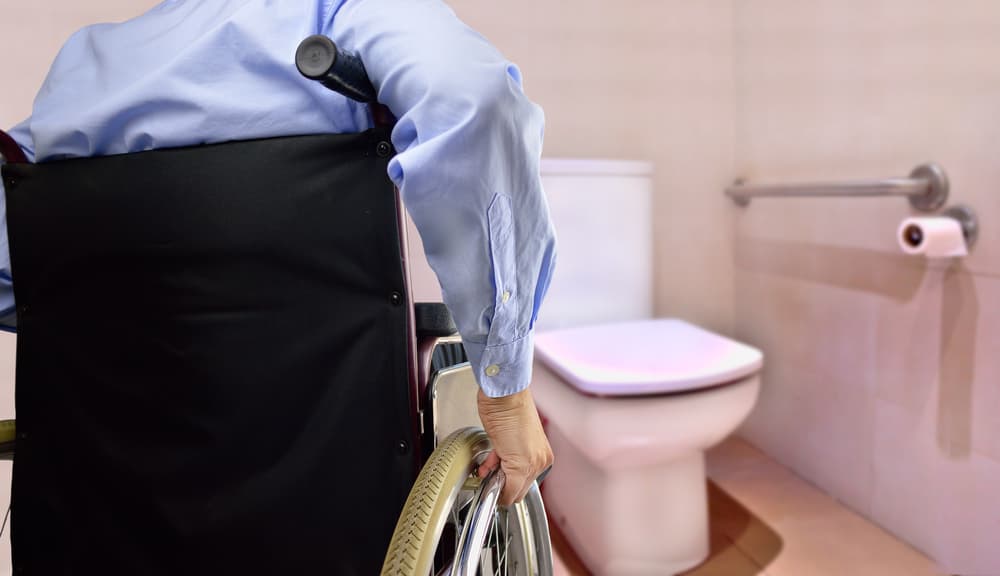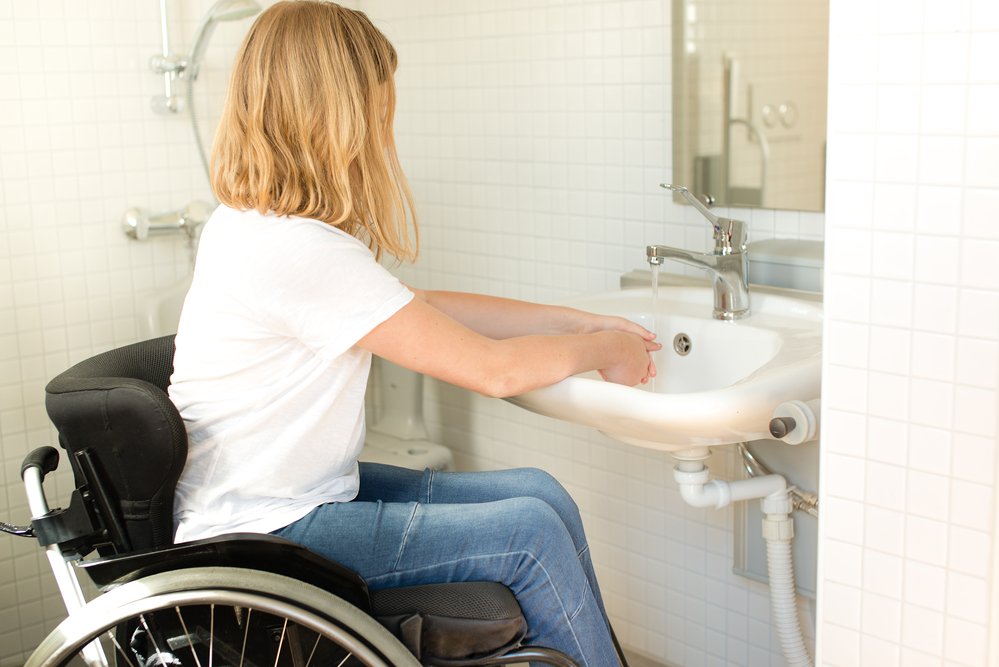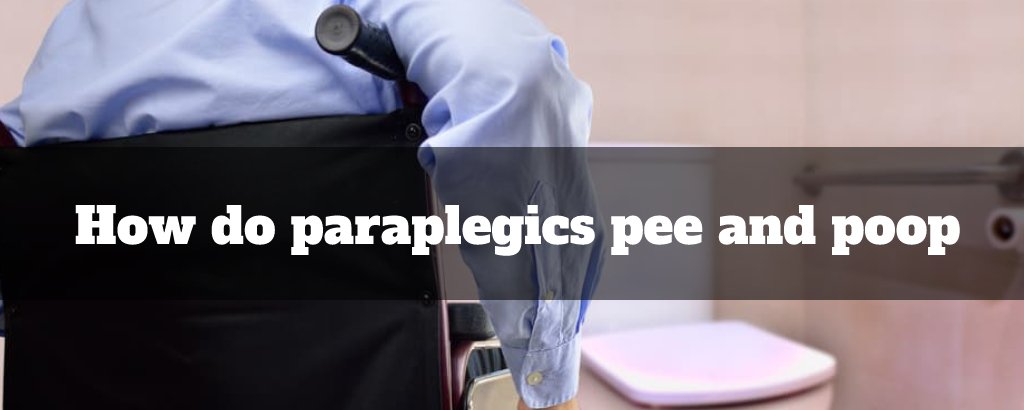Spinal cord injury can change how the bladder and bowel muscles work, making it harder for the bladder and buttocks to send information to the brain.
A spinal cord injury can cause a “neurogenic bladder” or “neurogenic bowel,” respectively, malfunctioning the urinary or digestive systems.
The science behind the dysfunction
The thoracic and sacral nerves, located near the chest and tailbone, regulate the bowels and bladder.
Damage to the sacral spinal cord following a spinal shock can affect the nerve signals that tell the brain to empty the bladder or bowel, resulting in an automatic, uncontrollable discharge of urine or feces or the inability to do so.
Spinal shock often lasts for a few days, but in the case of the bladder and bowel, it might last for several months or more.
Most of the time, the amount of function is proportional to the injury. Since most SCIs occur above the sacral nerve, expect issues with your intestines and bladder.
Bladder dysfunction after spinal cord injury
Almost 80% of people with spinal cord injuries will have bladder problems.
Depending on the degree of your injury, you may experience the following types of bladder dysfunction:
Flaccid bladder
The bladder will have lost its capacity to contract, resulting in increased elasticity. Urine will accumulate in the bladder and fill up to capacity, which is dangerous because if left untreated for too long, it can lead to urinary tract infections and kidney damage.
It often happens when damage to the spinal cord affects the sacral spinal nerves and the nerves below them.
Spastic bladder
A spastic bladder holds less urine than before spinal cord injury due to overactive bladder muscles, indicating the bladder reflex is essentially “over-active,” and the bladder may contract spontaneously and without notice.
An individual may experience urine urgency, yet the bladder may not empty with every contraction. This bladder type is common in individuals with SCI above the sacral level.
Mixed bladder
It has a mixed disruption in bladder function, affecting mixed spinal nerves. Sometimes you have no control over the need to urinate, while other times, you feel nothing but are still able to urinate.
Urinary tract infections, incontinence, kidney failure, kidney stones, and a general decline in quality of life can all result from bladder dysfunction.
Bowel dysfunction after spinal cord injury
Bowel problems are the most annoying issues reported by individuals with spinal cord injuries, with constipation affecting 40% of individuals.
When a spinal cord injury (SCI) occurs, neurogenic bowel can manifest in two ways:
Hyperreflexia or spastic bowel
If the spinal cord is damaged above the T-12 level, the ability to detect when the rectum is full may be lost. However, the anal sphincter muscle will remain contracted, resulting in reflexive bowel movements. You cannot sense the need, and your rectum cannot simply empty on its own.
Flaccid or areflexia bowl
A flaccid bowel is often caused by an SCI that disrupts the lower portion of the spinal cord or the nerve branches that extend to the intestine. In this situation, the sphincter muscle’s reflex control is compromised, resulting in your bowels emptying on their own and causing accidents.
Medications, alcohol, other substances, and diet can impact bowel function, requiring an efficient method for neurogenic bowel management.
Expert opinion about bladder and bowel treatment.

Mary Ann, a medical professional, shares the treatment regimens for the neurogenic bowel. A person with bowel incontinence can be taught procedures for bowel retraining. In most cases, a suppository is inserted into the rectum daily at the same time. The user can self-administer the lubricated suppository in bed once they are able. Then, after approximately 15 minutes, they may use the restroom. It all depends on their injuries’ severity and muscle control. Occasionally, the bowel becomes trained, and a person defecates while seated on the toilet. Success requires enormous perseverance, but the effort is well worth it.
Amanda Qunique, the occupational therapist, tells us how bladder function can be managed after a spinal cord injury via various methods and bladder programs.
9 out of 10 people with Spinal cord injury preferred to regain bowel and bladder function over walking in a survey. What options are there for them?
Treatment options for bladder management
After a spinal cord injury, it’s common to have problems with your bladder control or bowels, but there are ways to deal with them so that you can stay comfortable and independent.
Catheterization
When it comes to bladder care after a spinal cord injury, catheterization is the gold standard.
In the clean technique of intermittent catheterization (CIC), you or a healthcare practitioner put a catheter through the urethra and into the bladder many times each day to empty the bladder. This is a good option if you don’t want to use a catheter all the time.
An indwelling Foley catheter is a permanent catheter. This method increases the chance of infection in the urinary tract and is usually only used when intermittent catheterization is impossible.
Care must be taken with catheters as urine can pool for long durations, exposing the skin to the risk of wounds and infections that lead to sores.
Tapping
Detrusor muscle contractions and urination can be prompted by tapping the region over the bladder gently and frequently with the fingertips or the side of the hand.
Electrical Stimulation
An electrode set is implanted at the base of the spine during electrical stimulation. The device produces electric currents beneath the damaged site to stimulate neurons and improve motor function, which helps in bladder emptying.
Botox
Temporarily denervating spastic bladder muscles with Botox injections can increase bladder volume and decrease strain on the bladder muscle with a 73% success rate.
Surgical Methods
Bladder augmentation surgery is required for spastic bladder management. The bladder’s walls are enlarged during the surgery, reducing the need for frequent emptying.
Similar surgeries can be performed to enlarge the bladder. This procedure relaxes the bladder, neck, and sphincter muscles, allowing urine to flow more easily.
Anyone who urinates involuntarily after this procedure must wear a collection device such as condom catheters. Men use these collection devices to help with incontinence or after a sphincterotomy. As of yet, no such option is available for women.
Treatment options for bowel management
Any or all of the following may be incorporated into a bowel program:
Manual Removal
This method uses physical methods to remove poo from the rectum. It also entails creating pressure inside the belly by bearing down as if having a bowel movement, known as the Valsalva maneuver.
Suppositories and Laxatives
A wide range of over-the-counter and prescription medications might impact the regularity of your bowel movements. The typical active ingredients in these suppositories are bisacodyl and glycerin.
In terms of oral laxatives, you can choose among stool softeners, bulking agents, osmotic laxatives, and peristaltic stimulants.
High Fiber diet
Some patients have shown improvement after switching to a fiber-rich diet. However, the outcome may vary from person to person, so monitoring is advised, and more than a fiber-rich diet is needed.
Abdominal Massage
Sounds cliche, but according to a study, 15 minutes of abdominal massage 15 days in a row lowered intestinal transit time, decreased abdominal distension, and increased bowel motions per week.
Bowel Program
A bowel program sets up a routine for inducing bowel movements at set times. A bowel care program’s principal objective is to encourage frequent defecation for hygiene and good health.
Most of the time, the treatment starts with putting in a suppository or a mini-enema and then waiting 15 to 20 minutes for the stimulant to work. This part of the program should ideally be performed on a commode or toilet seat.
After the waiting time, digital stimulation is used every 10 to 15 minutes until the rectum is empty, but no more than four can be used at once. The majority of bowel programs take 30 to 60 minutes to finish.
Precautions Regarding the Bowel Program
No doubt the bowel program has found its use as the best to initiate bowel movement in people with spinal cord injuries, but precautions should be carriers, such as?
- Avoid too many laxatives.
- Don’t use full enemas.
- Skipping/changing the time of the bowel program can cause autonomic dysreflexia.
- Not following a proper diet.
How are people with spinal cord injuries managing?

Dave, who has been paralyzed for 22 years, says he has regained most of his bowel movements after a few years of injury. After that, he used to take fiber supplements, but as long as he regularly eats, drinks lots of water, and engages in moderate activity (such as pushing a wheelchair a mile or two every day), everything works well for him. Alcohol must be used with caution, he adds.
Craig from the YouTube channel “Para Life” shares his experiences managing his bowel movements. At 1:28, he starts to talk about solutions. He talks about his experiences with suppositories and concludes that anal irrigation is the best and most effective method.
In this video, Jannet Knudson and Shawn Fluke share their experiences with bowel program methods, mini enemas, digital stimulation, and surgical methods.
enny Smith, who has paraplegia, talks about how she has dealt with her bladder and bowels over the years.
All of these examples show that you should keep minor changes, such as bowel problems, from slowing down. Some physical changes have occurred, but you have not.
Before you go
In addition to having trouble with their bowels and bladders, people with paraplegia often have chronic pain as a severe complication of their condition. How does it affect them, and how can it be managed? Have a look at how people with paraplegia & quadriplegics feel pain.

